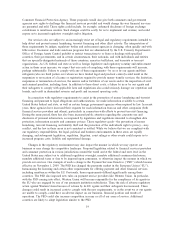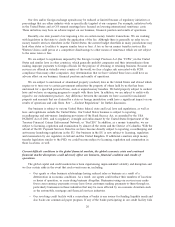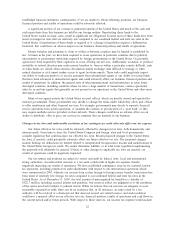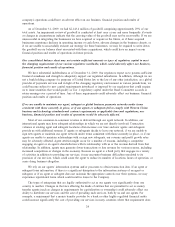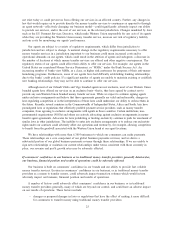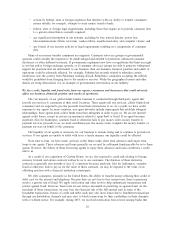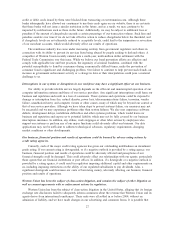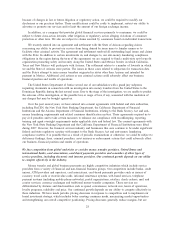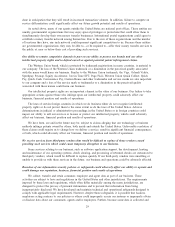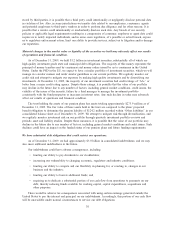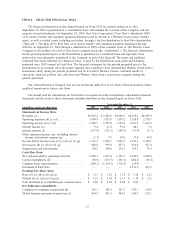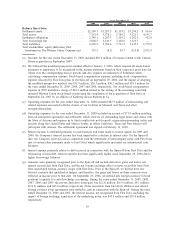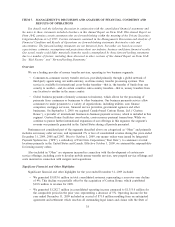Western Union 2009 Annual Report Download - page 42
Download and view the complete annual report
Please find page 42 of the 2009 Western Union annual report below. You can navigate through the pages in the report by either clicking on the pages listed below, or by using the keyword search tool below to find specific information within the annual report.because of changes in law or future litigation or regulatory action, we could be required to modify our
disclosures or our practices further. These modifications could be costly to implement, restrict our ability to
advertise or promote our services and/or limit the amount of our foreign exchange income.
In addition, as a company that provides global financial services primarily to consumers, we could be
subject to future class-action lawsuits, other litigation or regulatory action alleging violations of consumer
protection or other laws. We also are subject to claims asserted by consumers based on individual transactions.
We recently entered into an agreement and settlement with the State of Arizona regarding claims
concerning our ability to prevent our service from being abused by some users to launder money or to
facilitate other criminal activity. The agreement and settlement resolved all outstanding legal issues and claims
with the State. In addition to certain investments in, and changes to, our anti-money laundering compliance
obligations in the region during the term of the agreement, we are required to fund a multi-state not-for-profit
organization promoting safety and security along the United States and Mexico border, in which California,
Texas and New Mexico will participate with Arizona. The settlement relates to a number of lawsuits in which
we and the State of Arizona were parties. The issues in those cases related to subpoenas for transaction data
and the State’s attempt to seize money transfers originated in states other than Arizona and intended for
payment in Mexico. Additional civil actions or any criminal actions could adversely affect our business,
financial position and results of operations.
The United States Department of Justice served one of our subsidiaries with a grand jury subpoena
requesting documents in connection with an investigation into money transfers from the United States to the
Dominican Republic during the last several years. Due to the stage of the investigation, we are unable to predict
the outcome of the investigation, or the possible loss or range of loss, if any, associated with the resolution of
any charges that may be brought against us.
Over the past several years, we have entered into consent agreements with federal and state authorities,
including FinCEN, the New York State Banking Department, the California Department of Financial
Institutions and the Arizona Department of Financial Institutions, relating to the Bank Secrecy Act and anti-
money laundering requirements and related consumer identification matters. These agreements required us to
pay civil penalties and to take certain measures to enhance our compliance with recordkeeping, reporting,
training and agent oversight requirements under applicable state and federal law. The consent agreements with
the New York State Banking Department and the California Department of Financial Institutions were lifted
during 2007. However, the financial services industry and businesses like ours continue to be under significant
federal and state regulatory scrutiny with respect to the Bank Secrecy Act and anti-money laundering
compliance matters. It is possible that as a result of periodic examinations or otherwise, we could be subject to
deficiency findings, fines, criminal penalties, asset seizures or enforcement actions that could adversely affect
our business, financial position and results of operations.
We face competition from global and niche or corridor money transfer providers, United States and
international banks, card associations, card-based payments providers and a number of other types of
service providers, including electronic and internet providers. Our continued growth depends on our ability
to compete effectively in the industry.
Money transfer and global business payments are highly competitive industries which include service
providers from a variety of financial and non-financial business groups. Our competitors include banks, credit
unions, ATM providers and operators, card associations, card-based payments providers such as issuers of
e-money, travel cards or stored-value cards, informal remittance systems, web-based services, telephone
payment systems (including mobile phone networks), postal organizations, retailers, check cashers, mail and
courier services, currency exchanges and traditional money transfer companies. These services are
differentiated by features and functionalities such as speed, convenience, network size, hours of operations,
loyalty programs, reliability and price. Our continued growth depends on our ability to compete effectively in
these industries. We have made periodic pricing decreases in response to competition and to implement our
brand investment strategy, which includes better meeting consumer needs, maximizing market opportunities
and strengthening our overall competitive positioning. Pricing decreases generally reduce margins, but are
28



